[English] 日本語
 Yorodumi
Yorodumi- PDB-7sj7: Undecorated 13pf wildtype microtubule from recombinant human tubulin -
+ Open data
Open data
- Basic information
Basic information
| Entry | Database: PDB / ID: 7sj7 | ||||||
|---|---|---|---|---|---|---|---|
| Title | Undecorated 13pf wildtype microtubule from recombinant human tubulin | ||||||
 Components Components |
| ||||||
 Keywords Keywords | STRUCTURAL PROTEIN / microtubule / cell division / cytoskeleton / GTPase | ||||||
| Function / homology |  Function and homology information Function and homology informationnetrin receptor binding / Post-chaperonin tubulin folding pathway / dorsal root ganglion development / Cilium Assembly / cytoskeleton-dependent intracellular transport / Microtubule-dependent trafficking of connexons from Golgi to the plasma membrane / Carboxyterminal post-translational modifications of tubulin / Intraflagellar transport / Sealing of the nuclear envelope (NE) by ESCRT-III / Formation of tubulin folding intermediates by CCT/TriC ...netrin receptor binding / Post-chaperonin tubulin folding pathway / dorsal root ganglion development / Cilium Assembly / cytoskeleton-dependent intracellular transport / Microtubule-dependent trafficking of connexons from Golgi to the plasma membrane / Carboxyterminal post-translational modifications of tubulin / Intraflagellar transport / Sealing of the nuclear envelope (NE) by ESCRT-III / Formation of tubulin folding intermediates by CCT/TriC / Gap junction assembly / Prefoldin mediated transfer of substrate to CCT/TriC / Kinesins / Assembly and cell surface presentation of NMDA receptors / COPI-independent Golgi-to-ER retrograde traffic / COPI-dependent Golgi-to-ER retrograde traffic / Recycling pathway of L1 / RHOH GTPase cycle / RHO GTPases activate IQGAPs / microtubule-based process / intercellular bridge / Hedgehog 'off' state / Activation of AMPK downstream of NMDARs / cytoplasmic microtubule / COPI-mediated anterograde transport / Mitotic Prometaphase / peptide binding / EML4 and NUDC in mitotic spindle formation / cellular response to interleukin-4 / MHC class II antigen presentation / Recruitment of NuMA to mitotic centrosomes / axon guidance / Resolution of Sister Chromatid Cohesion / HSP90 chaperone cycle for steroid hormone receptors (SHR) in the presence of ligand / cell periphery / Translocation of SLC2A4 (GLUT4) to the plasma membrane / filopodium / RHO GTPases Activate Formins / PKR-mediated signaling / structural constituent of cytoskeleton / Aggrephagy / microtubule cytoskeleton organization / The role of GTSE1 in G2/M progression after G2 checkpoint / Separation of Sister Chromatids / HCMV Early Events / mitotic spindle / mitotic cell cycle / lamellipodium / double-stranded RNA binding / growth cone / microtubule cytoskeleton / Hydrolases; Acting on acid anhydrides; Acting on GTP to facilitate cellular and subcellular movement / microtubule / cilium / axon / cell division / neuronal cell body / GTPase activity / ubiquitin protein ligase binding / dendrite / GTP binding / structural molecule activity / extracellular exosome / metal ion binding / nucleus / cytoplasm Similarity search - Function | ||||||
| Biological species |  Homo sapiens (human) Homo sapiens (human) | ||||||
| Method | ELECTRON MICROSCOPY / helical reconstruction / cryo EM / Resolution: 3.8 Å | ||||||
 Authors Authors | LaFrance, B.J. / Greber, B.J. / Zhang, R. / McCollum, C. / Nogales, E. | ||||||
| Funding support |  United States, 1items United States, 1items
| ||||||
 Citation Citation |  Journal: Proc Natl Acad Sci U S A / Year: 2022 Journal: Proc Natl Acad Sci U S A / Year: 2022Title: Structural transitions in the GTP cap visualized by cryo-electron microscopy of catalytically inactive microtubules. Authors: Benjamin J LaFrance / Johanna Roostalu / Gil Henkin / Basil J Greber / Rui Zhang / Davide Normanno / Chloe O McCollum / Thomas Surrey / Eva Nogales /    Abstract: Microtubules (MTs) are polymers of αβ-tubulin heterodimers that stochastically switch between growth and shrinkage phases. This dynamic instability is critically important for MT function. It is ...Microtubules (MTs) are polymers of αβ-tubulin heterodimers that stochastically switch between growth and shrinkage phases. This dynamic instability is critically important for MT function. It is believed that GTP hydrolysis within the MT lattice is accompanied by destabilizing conformational changes and that MT stability depends on a transiently existing GTP cap at the growing MT end. Here, we use cryo-electron microscopy and total internal reflection fluorescence microscopy of GTP hydrolysis-deficient MTs assembled from mutant recombinant human tubulin to investigate the structure of a GTP-bound MT lattice. We find that the GTP-MT lattice of two mutants in which the catalytically active glutamate in α-tubulin was substituted by inactive amino acids (E254A and E254N) is remarkably plastic. Undecorated E254A and E254N MTs with 13 protofilaments both have an expanded lattice but display opposite protofilament twists, making these lattices distinct from the compacted lattice of wild-type GDP-MTs. End-binding proteins of the EB family have the ability to compact both mutant GTP lattices and to stabilize a negative twist, suggesting that they promote this transition also in the GTP cap of wild-type MTs, thereby contributing to the maturation of the MT structure. We also find that the MT seam appears to be stabilized in mutant GTP-MTs and destabilized in GDP-MTs, supporting the proposal that the seam plays an important role in MT stability. Together, these structures of catalytically inactive MTs add mechanistic insight into the GTP state of MTs, the stability of the GTP- and GDP-bound lattice, and our overall understanding of MT dynamic instability. #1:  Journal: BioRxiv / Year: 2021 Journal: BioRxiv / Year: 2021Title: Structural transitions in the GTP cap visualized by cryo-EM of catalytically inactive microtubules Authors: LaFrance, B.J. / Roostalu, J. / Henkin, G. / Greber, B.J. / Zhang, R. / Normanno, D. / McCollum, C. / Surrey, T. / Nogales, E. | ||||||
| History |
|
- Structure visualization
Structure visualization
| Movie |
 Movie viewer Movie viewer |
|---|---|
| Structure viewer | Molecule:  Molmil Molmil Jmol/JSmol Jmol/JSmol |
- Downloads & links
Downloads & links
- Download
Download
| PDBx/mmCIF format |  7sj7.cif.gz 7sj7.cif.gz | 876.9 KB | Display |  PDBx/mmCIF format PDBx/mmCIF format |
|---|---|---|---|---|
| PDB format |  pdb7sj7.ent.gz pdb7sj7.ent.gz | 736.7 KB | Display |  PDB format PDB format |
| PDBx/mmJSON format |  7sj7.json.gz 7sj7.json.gz | Tree view |  PDBx/mmJSON format PDBx/mmJSON format | |
| Others |  Other downloads Other downloads |
-Validation report
| Summary document |  7sj7_validation.pdf.gz 7sj7_validation.pdf.gz | 1.8 MB | Display |  wwPDB validaton report wwPDB validaton report |
|---|---|---|---|---|
| Full document |  7sj7_full_validation.pdf.gz 7sj7_full_validation.pdf.gz | 1.9 MB | Display | |
| Data in XML |  7sj7_validation.xml.gz 7sj7_validation.xml.gz | 143.2 KB | Display | |
| Data in CIF |  7sj7_validation.cif.gz 7sj7_validation.cif.gz | 207.3 KB | Display | |
| Arichive directory |  https://data.pdbj.org/pub/pdb/validation_reports/sj/7sj7 https://data.pdbj.org/pub/pdb/validation_reports/sj/7sj7 ftp://data.pdbj.org/pub/pdb/validation_reports/sj/7sj7 ftp://data.pdbj.org/pub/pdb/validation_reports/sj/7sj7 | HTTPS FTP |
-Related structure data
| Related structure data |  25156MC  7sj8C  7sj9C  7sjaC M: map data used to model this data C: citing same article ( |
|---|---|
| Similar structure data |
- Links
Links
- Assembly
Assembly
| Deposited unit | 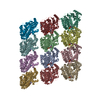
|
|---|---|
| 1 |
|
- Components
Components
| #1: Protein | Mass: 51033.324 Da / Num. of mol.: 6 Source method: isolated from a genetically manipulated source Source: (gene. exp.)  Homo sapiens (human) / Gene: TUBA1B / Plasmid: pFastBacDual / Cell line (production host): High Five / Production host: Homo sapiens (human) / Gene: TUBA1B / Plasmid: pFastBacDual / Cell line (production host): High Five / Production host:  Trichoplusia ni (cabbage looper) / References: UniProt: P68363 Trichoplusia ni (cabbage looper) / References: UniProt: P68363#2: Protein | Mass: 51276.367 Da / Num. of mol.: 6 Source method: isolated from a genetically manipulated source Source: (gene. exp.)  Homo sapiens (human) / Gene: TUBB3, TUBB4 / Plasmid: pFastBacDual / Cell line (production host): High Five / Production host: Homo sapiens (human) / Gene: TUBB3, TUBB4 / Plasmid: pFastBacDual / Cell line (production host): High Five / Production host:  Trichoplusia ni (cabbage looper) / References: UniProt: Q13509 Trichoplusia ni (cabbage looper) / References: UniProt: Q13509#3: Chemical | ChemComp-GTP / #4: Chemical | ChemComp-MG / #5: Chemical | ChemComp-GDP / Has ligand of interest | Y | |
|---|
-Experimental details
-Experiment
| Experiment | Method: ELECTRON MICROSCOPY |
|---|---|
| EM experiment | Aggregation state: HELICAL ARRAY / 3D reconstruction method: helical reconstruction |
- Sample preparation
Sample preparation
| Component | Name: 13pf wildtype undecorated microtubule from recombinant human tubulin Type: COMPLEX / Entity ID: #1-#2 / Source: RECOMBINANT |
|---|---|
| Molecular weight | Value: 0.102 MDa / Experimental value: NO |
| Source (natural) | Organism:  Homo sapiens (human) Homo sapiens (human) |
| Source (recombinant) | Organism:  Trichoplusia ni (cabbage looper) / Cell: High-Five Insect Cell / Plasmid: pFastBacDual Trichoplusia ni (cabbage looper) / Cell: High-Five Insect Cell / Plasmid: pFastBacDual |
| Buffer solution | pH: 6.8 Details: 80 mM PIPES, 1 mM EGTA, 5 mM MgCl2, 2 mM GTP, pH 6.8 |
| Specimen | Conc.: 4.4 mg/ml / Embedding applied: NO / Shadowing applied: NO / Staining applied: NO / Vitrification applied: YES Details: 44 uM [wildtype tubulin] assembled and pseudo-helical microtubules adsorbed onto the grid |
| Specimen support | Grid material: COPPER / Grid mesh size: 300 divisions/in. / Grid type: C-flat-1.2/1.3 |
| Vitrification | Cryogen name: ETHANE-PROPANE |
- Electron microscopy imaging
Electron microscopy imaging
| Experimental equipment |  Model: Titan Krios / Image courtesy: FEI Company |
|---|---|
| Microscopy | Model: FEI TITAN KRIOS |
| Electron gun | Electron source:  FIELD EMISSION GUN / Accelerating voltage: 300 kV / Illumination mode: FLOOD BEAM FIELD EMISSION GUN / Accelerating voltage: 300 kV / Illumination mode: FLOOD BEAM |
| Electron lens | Mode: BRIGHT FIELD / Nominal magnification: 64000 X / Nominal defocus max: 2500 nm / Nominal defocus min: 500 nm / Cs: 2.6 mm |
| Specimen holder | Cryogen: NITROGEN / Specimen holder model: FEI TITAN KRIOS AUTOGRID HOLDER |
| Image recording | Electron dose: 40 e/Å2 / Detector mode: SUPER-RESOLUTION / Film or detector model: GATAN K2 SUMMIT (4k x 4k) |
- Processing
Processing
| Software | Name: PHENIX / Version: 1.18_3845: / Classification: refinement | ||||||||||||||||||||||||||||||||||||||||
|---|---|---|---|---|---|---|---|---|---|---|---|---|---|---|---|---|---|---|---|---|---|---|---|---|---|---|---|---|---|---|---|---|---|---|---|---|---|---|---|---|---|
| EM software |
| ||||||||||||||||||||||||||||||||||||||||
| Image processing | Details: Images collected in super-resolution mode, Motioncorr2 5x5 binning of frames | ||||||||||||||||||||||||||||||||||||||||
| CTF correction | Details: CTFFind4 and CTFRefine were used within the RELION3.1 framework. Type: PHASE FLIPPING AND AMPLITUDE CORRECTION | ||||||||||||||||||||||||||||||||||||||||
| Helical symmerty | Angular rotation/subunit: 0.05 ° / Axial rise/subunit: 81.5 Å / Axial symmetry: C1 | ||||||||||||||||||||||||||||||||||||||||
| Particle selection | Details: Microtubules were picked within RELION 3.1 helical picking functionality and extracted along the filament with an 82A sliding box. | ||||||||||||||||||||||||||||||||||||||||
| 3D reconstruction | Resolution: 3.8 Å / Resolution method: FSC 0.143 CUT-OFF / Num. of particles: 19365 / Num. of class averages: 1 / Symmetry type: HELICAL | ||||||||||||||||||||||||||||||||||||||||
| Atomic model building | B value: 115 / Protocol: RIGID BODY FIT / Space: REAL / Target criteria: Correlation Coefficient | ||||||||||||||||||||||||||||||||||||||||
| Atomic model building | PDB-ID: 6DPU Accession code: 6DPU / Source name: PDB / Type: experimental model | ||||||||||||||||||||||||||||||||||||||||
| Refine LS restraints |
|
 Movie
Movie Controller
Controller








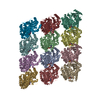


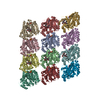
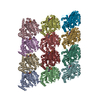
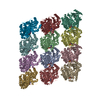
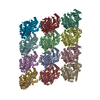
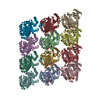

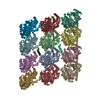
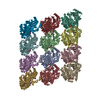
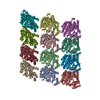
 PDBj
PDBj


































